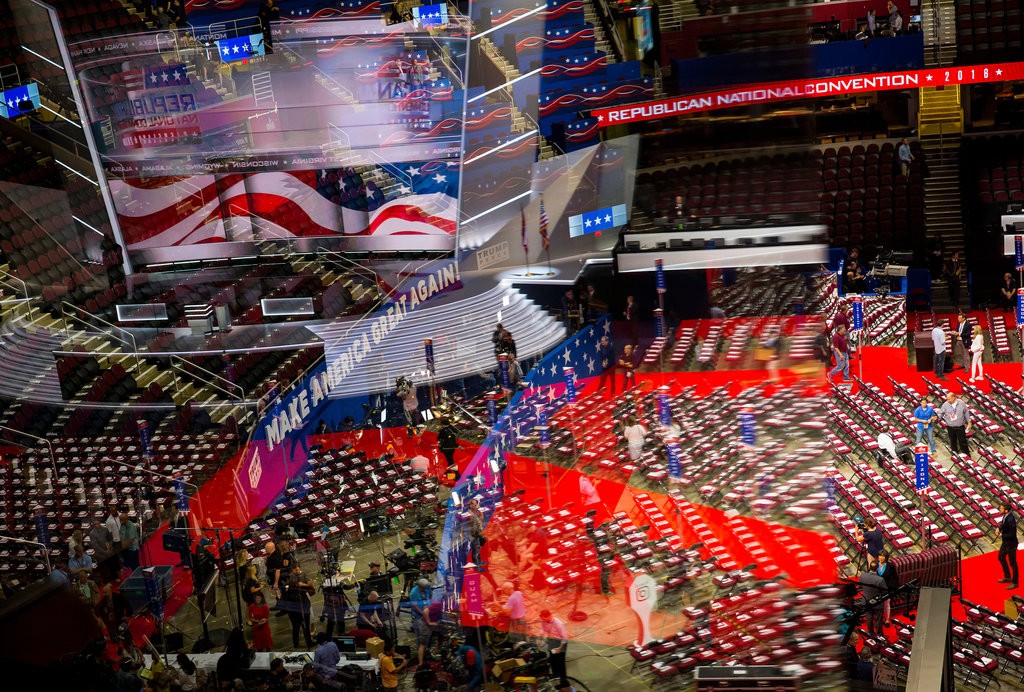 The floor of the Quicken Loans Arena, site of the 2016 Republican National Convention.
The floor of the Quicken Loans Arena, site of the 2016 Republican National Convention.
Most of this is obvious by now, but its valuable to recognize ongoingly. Well written summation. Worth reading.
Courtesy NYTimes, OP-Contributor, Peter Sudman
If the modern Republican Party can be said to stand for anything, it is tax relief. Yet as the Republican effort to write and pass tax legislation develops, it looks increasingly possible — and perhaps even likely — that it, like the health care overhaul attempt that preceded it, will end in failure and disappointment.
When the year began, the speaker of the House, Paul Ryan, cited health care and taxes as his top legislative priorities, predicting that both would be completed by August. Yet after nine months of party control of Congress and the White House, the Republicans have accomplished essentially nothing. They have become a party without a consensus.
It would be easy to simply blame the president for the party’s disarray. Donald Trump’s aversion to policy detail, his chaotic management style and his combustible personality have all contributed to the party’s failures this year.
Yet it would also be a mistake to pin the party’s problems on Mr. Trump alone. He is not their root cause. Instead, he is an avatar of the party’s pathologies, the culmination of its cynical and shambolic trajectory over the last two decades.
Many of those issues can be traced back to the administration of George W. Bush, which functioned as an enormous political bait and switch. The 43rd president campaigned on humble foreign policy and prudent conservative solutions, but his presidency quickly became oriented almost exclusively around a political defense of the Iraq war.
This meant that domestic policy, and the realm of domestic policy expertise, became an afterthought at best, an opportunity for cynical political maneuvering at worst.
But Mr. Bush’s post-Sept. 11 popularity instilled the administration with an arrogance that extended far beyond the war itself. The president’s inner circle became convinced that the Republican Party was destined for years of unbroken political domination; the ambition-spoiling concerns of the “reality-based community” no longer needed to be taken into account.
National security fear-mongering and culture war controversies, especially over same-sex marriage, were employed to rally the base and ensure its loyalty, even as dissatisfaction with Mr. Bush’s governance continued to grow.
The Bush presidency, then, was both a failure and a fraud. Instead of foreign policy restraint and modest conservative governance, the Bush administration delivered a pair of endless deficit-financed wars, cynical posturing over social issues, soaring federal spending and, eventually, a large-scale emergency intervention in the economy.
Arguably as important as the particular failures themselves, however, was the way the party infrastructure — its leaders and functionaries, its activists and operators — formed a partisan phalanx around the president, playing down his flaws, if not refusing to acknowledge them.
There is always some space between a party’s voters and its leaders, some difference between what the average supporter wants and what the elected representatives are willing to do. But by excusing Mr. Bush’s errors, Republicans radically expanded the trust deficit, creating a yawning gap between the party’s base and its elites, one that has persisted, and grown, in the years since.
In many ways the party’s hangups stem from its unwillingness to fully reckon with the Bush legacy.
Mr. Bush left many voters on the right angry, resentful and suspicious — of war, of policy, of ideology, of the very idea of political solutions and leadership.
The focal point for much of the post-Bush right’s anger and resentment was the Tea Party, a decentralized movement that variously mixed genuine desire for limited government with white resentment and flare-ups of outright paranoia. It attracted hucksters and manipulators, in the media and in the activist sphere, and embraced a cast of unconventional and unqualified candidates.
Republican Party elites were only too happy to exploit this inchoate energy as long as it was useful. This is how John McCain ended up selecting an untested firebrand like Sarah Palin as his presidential running mate and how Mitt Romney campaigned with sideshow characters like Kid Rock and, well, eventually Donald Trump.
The partisan push for the Affordable Care Act under President Barack Obama further amplified these frustrations, which helped Republicans take over the House in 2010.
The defeats of both Mr. McCain and Mr. Romney left the party leaderless, and Mr. Bush’s shredded reputation meant it could not follow the course he had laid out. So the party became defined by what was left: its resentments and suspicions, its antagonisms and obsessions, its anger and its differences. It retreated into tribalism and anti-intellectualism. Eventually, the sideshow became the main event.
Mr. Trump, of course, is the biggest sideshow of them all. He exploited the gap between the base and the elites, embodying the dysfunction and disarray that already existed.
Like all presidents, he serves an organizing function for his party, orienting it around broad goals. But Mr. Trump’s goals have more to do with Twitter feuds and personal aggrandizement than any particular policies. Under Mr. Trump, the party’s chief internal debate is not so much about which governing vision to pursue but whether there should be one at all.
This reality is not lost on all Republicans. Representative Thomas Massie, Republican of Kentucky, one of the party’s most libertarian members, recently said that when he realized that primary voters backed him and his fellow libertarians Rand Paul and Ron Paul, it wasn’t for their ideas. Instead, he said, “they were voting for the craziest son of a bitch in the race — and Donald Trump won best in class.”
Republican voters weren’t voting for any policy outcome. They were voting for chaos. And that, more than anything, is what the party has come to stand for.
A more conventional Republican president might have smoothed over some of these intraparty conflicts, and almost certainly would have managed passing legislation with more skill. But the essential divisions would still have existed.
For years before Mr. Trump was elected, Republicans lacked a consensus plan to replace Obamacare, and their tax reform plans were vague. Republicans blew up the deficit under Mr. Bush before complaining about it under Mr. Obama, and the party has fought bitter internal battles over immigration for decades.
Republican voters, meanwhile, were attracted to shallow political entertainers and obviously unqualified candidates long before Mr. Trump threw his hat in the ring.
Mr. Trump didn’t cause any of this. He just took advantage of it. He is the most successful huckster of the bunch.
While party leaders were quiet under Mr. Bush, some today seem willing to speak out, however haltingly, against Mr. Trump. Republicans would benefit from more of that sort of critical introspection, but it is not enough. Because someday, Mr. Trump will no longer be president. And the Republicans will probably still be the same dysfunctional and disappointing party it is today.
